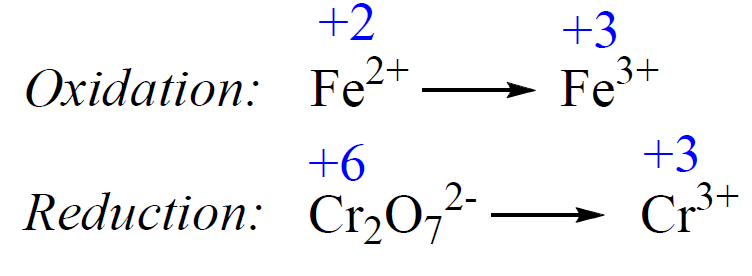Electrochemistry practice problems include questions on balancing redox reactions in acidic and basic solutions, calculating the cell potential, Eo/E at standard conditions using the table of standard reduction potentials, calculating the free energy change, ΔG based on the cell potential, calculating the cell potential under nonstandard conditions using the Nernst equation, calculating the equilibrium constant of the reaction based on the cell potential.
Practice
Balance the following redox reactions occurring in acidic aqueous solution:
a) Al(s) + Fe2+(aq) → Al3+(aq) + Fe(s)
b) SO32–(aq) + MnO4–(aq) → SO42–(aq) + Mn2+(aq)
c) Cr2O72-(aq) + C2O22-(aq) → Cr3+(aq) + CO2(g)
d) PbO2(s) + Mn2+(aq) + SO42-(aq) → PbSO4(s) + MnO4–(aq)
e) MnO4–(aq) + H2O2(aq) → Mn2+(aq) + O2(g)
Balance the following redox reactions occurring in basic aqueous solution:
a) Mn2+(aq) + ClO3–(aq) → MnO2(s) + ClO2(g)
b) MnO4–(aq) + Br–(aq) → MnO2 + BrO3–(aq)
c) MnO4–(aq) + CN–(aq) → CNO–(aq) + MnO2(s)
d) H2O2(aq) + ClO2(aq) → ClO2–(aq) + O2(g)
e) MnO4–(aq) + Fe(OH)2(s) → MnO2(s) + Fe(OH)3(s)
For each redox reaction, sketch a voltaic cell, label the anode and cathode, and indicate the half-reaction that occurs at each electrode. Show the direction of electron flow and the species present in each solution.
a) Cu2+(aq) + 2e– → Cu(s)
Sn(s) → Sn2+(aq) + 2e–
b) Cd2+(aq) + 2e– → Cd(s)
Mn(s) → Mn2+(aq) + 2e–
Given the values of standard reduction potentials, determine the redox reaction that will occur in a galvanic cell. Sketch a voltaic cell, label the anode and cathode, and indicate the half-reaction that occurs at each electrode. Show the direction of electron flow and the species present in each solution.
Pb2+(aq) + 2e– → Pb(s) Eo = -0.13 V
Ag+(aq) + e– → Ag(s) Eo = 0.80 V
Calculate the E°cell for each balanced redox reaction and determine if the reaction is spontaneous as written.
a) Ni(s) + Mg2+(aq) → Ni2+(aq) + Mg(s)
b) 2Cl–(aq) + Pb2+ (aq) → Cl2(l) + Pb(s)
c) Cd(s) + Pb2+(aq) → Cd2+(aq) + Pb(s)
d) Fe(s) + 3Ag+(aq) → Fe3+(aq) + 3Ag(s)
e) Ca2+(aq) + Fe(s) → Ca(s) + Fe2+(aq)
Balance the following redox reaction occurring in acidic media, and using a table for standard electrode potentials, determine the Eocell at 25 oC.
Cd(s) + Cr2O72−(aq) → Cd2+(aq) + Cr3+(aq)
Determine the balanced net reaction from the following two half-reactions and calculate the Eocell at 25 oC.
NO(g) + 2H2O(l) ⟶ NO3−(aq) + 4H+(aq) + 3e− E° = -0.96 V
MnO2(s) + 4H+(aq) + 2e− ⟶ Mn2+(aq) + 2H2O(l) E° = 1.21 V
Using a table for standard electrode potentials, find a metal that can be used to reduce Al3+ ions but not Na+ ions.
Using a table for standard electrode potentials, determine if Fe can be used to reduce the Sn2+ ion.
Using a table for standard electrode potentials, determine if H2(g) is capable of reducing Cd2+(aq).
Cell Potential, Free Energy, and the Equilibrium Constant
Use tabulated electrode potentials to calculate ΔG°rxn for each reaction at 25 °C.
a) Zn(s) + Pb2+(aq) → Zn2+(aq) + Pb(s)
b) Sn2+(aq) + Mg(s) → Sn(s) + Mg2+(aq)
c) Br2(l) + 2I–(aq) → 2Br–(aq) + I2(s)
d) 2Al(s) + 3Cu2+(aq) → 2Al3+(aq) + 3Cu(s)
e) O2(g) + 4H+(aq) + Cu(s) → Cu2+(aq) + 2H2O(l)
f) MnO2(s) + 4H+(aq) + Cd(s) → Mn2+(aq) + 2H2O(l ) + Cd2+(aq)
Calculate the equilibrium constant for each redox reaction in problem 11.
a) Zn(s) + Pb2+(aq) → Zn2+(aq) + Pb(s)
b) Sn2+(aq) + Mg(s) → Sn(s) + Mg2+(aq)
c) Br2(l) + 2I–(aq) → 2Br–(aq) + I2(s)
d) 2Al(s) + 3Cu2+(aq) → 2Al3+(aq) + 3Cu(s)
e) O2(g) + 4H+(aq) + Cu(s) → Cu2+(aq) + 2H2O(l)
f) MnO2(s) + 4H+(aq) + Cd(s) → Mn2+(aq) + 2H2O(l ) + Cd2+(aq)
Use an appendix for the free energies of formation to calculate the standard cell potential for the oxidation reaction of ethylene, C2H4 by permanganate ion, MnO4–.
5C2H4(g) + 12MnO4–(aq) + 36H+(aq) → 10CO2(g) + 12Mn2+(aq) + 28H2O(l)
The standard free energy of formation for Mn2+ ions is -228 kJ/mol.
The Nernst Equation
A voltaic cell runs the following redox reaction:
Fe2+(aq) + Mg(s) → Mg2+(aq) + Fe(s)
Determine whether Ecell is larger or smaller than E°cell and determine the Ecell for the following concentrations:
a) when [Fe2+] = 1.0 M and [Mg2+] = 2.5 M
b) when [Fe2+] = 3.0 M and [Mg2+] = 1.0 M
Calculate E°, E, and ΔG for the following cell reaction:
Mn(s) + Pb2+(aq) → Mn2+(aq) + Pb(s)
[Mn2+] = 0.164 M, [Pb2+] = 0.038 M
A galvanic cell operates on the following redox reaction:
2MnO4–(aq) + 10Br–(aq) + 16H+(aq) → 2Mn2+(aq) + 5Br2(l) + 8H2O(l)
Calculate the cell potential at 25 oC, given the concentrations of the aqueous components are: [MnO4–] = 0.0250 M, [Br–] = 0.0150 M, [Mn2+] = 0.380 M, and [H+] = 0.64 M.
A voltaic cell consists of a Mg/Mg2+ half-cell and a Sn/Sn2+ half-cell at 25 °C. The initial concentrations of Sn2+ and Mg2+ are 1.80 M and 0.250 M, respectively.
a) Calculate the initial cell potential.
b) What is the cell potential when the concentration of Sn2+ dropped to 0.650 M?
c) Determine the concentrations of Sn2+ and Mg2+ ions when the cell potential falls to 2.15 V.
A voltaic cell consists of a Zn/Zn2+ half-cell and a H2/H+ half-cell at 25 °C. Calculate the initial cell potential if [Zn2+] = 0.0250 M, [H+] = 2.80 M, P(H2) = 0.45 atm.
Determine the emf of a cell consisting of a Sn2+/Sn half-cell and a Pt/H+/H2 half-cell if [Sn2+] = 0.12 M, [H+] = 0.0650 M, and P(H2) = 1.25 atm?


I think the wrong standard E(cell) number was used for the final calculation in the solution to question 16. The calculated standard E(cell) number is 0.42V, but the final calculation shows it being one of the half-reactions potential, 1.51V.
Yes, that is correct. Fixed – thank you!